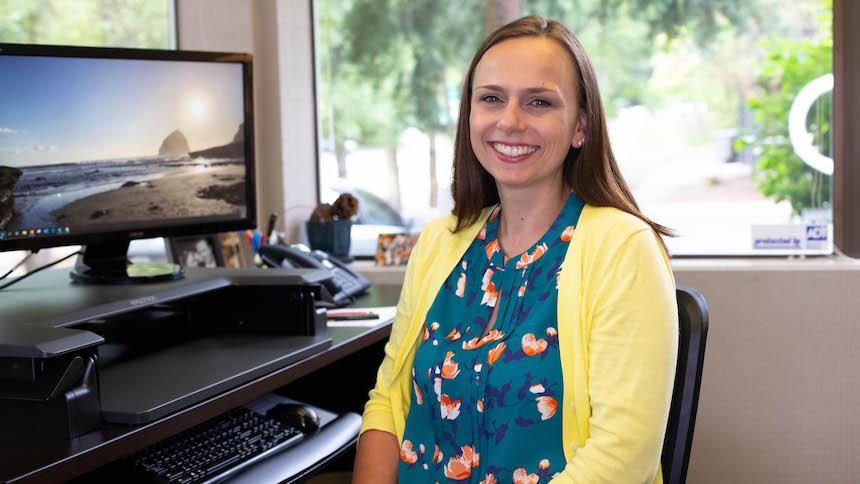Coronavirus Transforms the Way Teachers Relate to Students
Classrooms may never be the same.
After an on-and-off, widespread lockdown that sent students and teachers home for 18 months and counting, educators at Pacific University and elsewhere are emerging from the COVID-19 pandemic with a renewed appreciation for the elements of the delicate process of learning. And they say they’ve seen changes in their students.
“The biggest thing was to give kids an outlet, to let them communicate what they were feeling; whether in writing or via our online meetings.”
—Tim Foster ’06, MAT ’09
“In the spring of 2020, there was definitely a lot of fear and apprehension around COVID and what was happening with the stay-at-home orders and online schooling. The biggest thing was to give kids an outlet, to let them communicate what they were feeling; whether in writing or via our online meetings,” said Tim Foster ’06, MAT ’09, who teaches English at Pendleton High School in Pendleton, Ore.
“Coming into this last fall, it was a lot of the same, but kids were exhausted. They were getting burned out with the constant changes at the national and state levels. Online school, to hybrid, to potentially full-day school again. Sports were going to start, then not, then they were played in different seasons. They just wanted to know what to expect, and it was hard to give them a clear idea. Hopefully we are in a place soon where we can give kids some stability again.”
An interdisciplinary team of Pacific University faculty in occupational therapy, audiology and optometry is studying the impact of prolonged virtual learning during the COVID-19 pandemic on K-12 children. Parents and healthcare practitioners are invited to participate in a survey regarding any changes they might have noticed in children due to the distance learning environment. The survey has been approved by the university’s Institutional Research Board and takes about 20 minutes.
Take the survey by Nov. 7.
Contact ergonomics@groups.pacificu.edu with questions.
Fears of infection by the COVID-19 virus pushed educators and students to take extraordinary measures in an effort to keep academics on track. But the effort, marked by shuttered classrooms, glitchy technology and, in many cases, bored, disengaged kids, has taken a massive and still undefined toll.
Faculty at Pacific are conducting research on the impact of distance learning on children. The U.S. Department of Education’s Office of Civil Rights observed that the pandemic widened learning gaps, especially for students of color in public schools, students with disabilities and those learning English. It also said evidence suggests students fell further behind in core subjects such as math and reading. And the office said there are signs that students’ mental wellbeing has suffered from the lack of direct, human contact.
“These disparities can be a cause for great concern, especially when they interfere with a student’s opportunity to learn, grow, and contribute to our nation’s future,” wrote Suzanne B. Goldberg, the agency’s acting assistant secretary for civil rights.
The very nature of online learning changed classroom dynamics, noted Lucy Mercer, who was an exchange student at Pacific from York, England, in 2012 and now teaches the humanities at Rugby Free Secondary School in Rugby, England.
“Learning is slower online and that’s okay, as it also shows us perhaps we speed through too much and don’t always check understanding and comprehension,” she said in an email. “Face to face, some children are embarrassed to ask for help. Online is different. Some who thrive in a classroom struggle online if things are not explicit.
“For some, online learning was better as it took away anxiety and pressure to conform in a classroom,” she said. “If no one can see what works for you, you are at the mercy of your own creativity. For others, their home life is a barrier to their learning.”
Mercer said the pandemic made it plain that access to internet connected computers is a necessity for students, not a luxury. And educators must keep up with fast-evolving technologies. She said she used online chat functions and breakout “rooms” to provide individual attention to students as needed.

The return to even partly full classrooms boosted student morale, noted David Larsen '03, who is director of instrumental studies at Spokane Falls (Wash.) Community College.
“Teaching through COVID taught me how much students really want to be in the classroom,” he said via email. “As we transitioned from fully online to partially in person, students’ attitudes improved and gave them a real sense of accomplishment when we were finally able to get back to in-person teaching.”
Larsen said he’s eager to a return to a more normal schedule this fall, with a return to in-person musical performances for live audiences.
Teachers, students and parents everywhere share the sentiment. It’s been an experience to learn from, but not to repeat. ■
This story appears in the Fall 2021 issue of Pacific magazine. For more stories, visit pacificu.edu/magazine.



